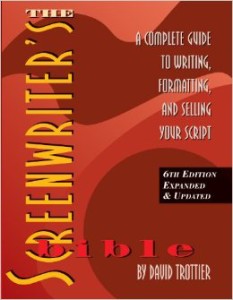 This “Bible” is very informative, detailed, well-organized and accessible; more comprehensive and with a wider range of examples than Syd Field’s classic, Screenplay. On the other hand, it’s nearly 500 pages of 8.5” x 11” text, so it’s formidable. Despite that, it wears its organization on its sleeve and is easy to navigate.
This “Bible” is very informative, detailed, well-organized and accessible; more comprehensive and with a wider range of examples than Syd Field’s classic, Screenplay. On the other hand, it’s nearly 500 pages of 8.5” x 11” text, so it’s formidable. Despite that, it wears its organization on its sleeve and is easy to navigate.
Five “Books,” or sections of about equal length, describe and discuss various aspects of writing and selling your script. The first three sections cover basic principles of storytelling, how to write a script (or any compelling story), and a style guide for scriptwriting – mainly for movies, but also television. A fine section in the middle gives many good and bad script examples with a “scriptwriting consultant’s” commentary. You’d pay thousands to glean this information from an actual consultant, or even to attend a conference with this level of detail. The last section is on how to sell your script, a more difficult process than writing it in the first place.
I enjoyed the first two sections most, the principles and methods for telling a good story. I’ve read dozens of books on these topics and have written several novels, yet I still struggle. Trottier’s approach adheres closely to Aristotle’s Poetics, probably still the best how-to-write guide ever. Trottier is especially strong in simplifying character motivation, and offers some useful worksheets.
The Style Guide de-mystifies the arcane rules of formatting a screenplay, and emphasizes simplicity in a spec script, as opposed to a production script. He wisely emphasizes that the spec script should avoid virtually all editing and camera direction and just tell a good story.
The final section on marketing (sales are pre-supposed), is daunting indeed. I should be so lucky to get that far. But having marketed several novels and even agented one, I can say that his advice is helpful and one-hundred-percent solid in my experience. That doesn’t make it any less of a mountain to climb.
Despite its overall strong organization, the book is a compendium and often reads like a set of laundry lists without much connecting tissue, and sometimes topics seem out of order (like introducing the character/action grid after discussion of the draft revision), and sometimes just inserted at random (like a brief description of a hero’s mythical journey).
In the center of the chapter on how to write your script, helpful preparatory outlining procedures are described then there’s this: “Step 6 – Write your first draft.” That’s it! That’s like the famous recipe for rabbit stew: “First, catch the rabbit.”
Actually, all the detailed information you need to execute “Step 6” has been previously discussed, though this is a glaring example of lack of connecting tissue. This “Bible” is more of a reference guide than a step-by-step how-to, but the attentive reader can put it all together and maybe that’s better than trying to follow a recipe.
Trottier, David. (2014) The Screenwriter’s Bible, 6th Ed. Los Angeles, CA: Silman-James Press (442 pp).
